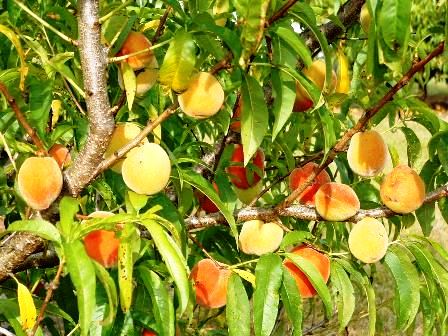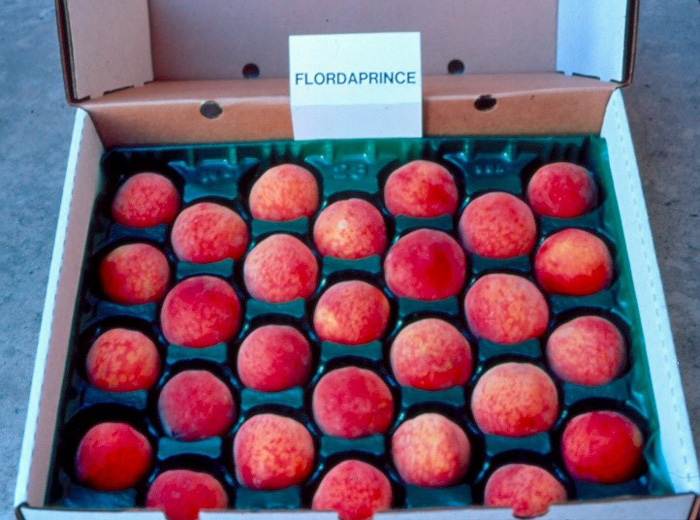 Prunus species require the accumulation of cold winter temperatures to allow for normal bud development and budbreak in the spring. Traditional temperate zone peach and nectarine cultivars require 800 to 1200 hours of cumulative hourly temperatures of 45oF or less during the dormant season, which is much too high for Florida. Dr. Ralph Sharpe initiated a peach breeding program in the 1950’s at the University of Florida. His objectives were to produce high quality peach cultivars with a short fruit development period that required very little winter chilling. Early fruit ripening during late April and May was essential in order to fill a market window with little or no competition from California, or other peach fruit producing regions.
Prunus species require the accumulation of cold winter temperatures to allow for normal bud development and budbreak in the spring. Traditional temperate zone peach and nectarine cultivars require 800 to 1200 hours of cumulative hourly temperatures of 45oF or less during the dormant season, which is much too high for Florida. Dr. Ralph Sharpe initiated a peach breeding program in the 1950’s at the University of Florida. His objectives were to produce high quality peach cultivars with a short fruit development period that required very little winter chilling. Early fruit ripening during late April and May was essential in order to fill a market window with little or no competition from California, or other peach fruit producing regions.
Historically, Florida has had a small peach industry peaking at about 3,000 acres during the early 1980’s. The north Florida/south Georgia peach industry consisted of peach cultivars with a chilling requirement between 350 and 650 hours of cumulative temperatures below 45 oF. The Florida industry, which was centered in Madison County, suffered from variable weather patterns; late winter freezes or frost damage in some years, and inadequate chilling in other years. There has been a resurgence of interest in growing peaches in central and south central Florida with the development of very low chill peach cultivars that require 150 hours or less of winter chilling. Flordaprince, UFOne, UFSun,UFBest, and Tropic Beauty are being grown as far south as Ft. Meyers and Immokalee.
 The impetus for tropical peach production is the high value of peaches that ripen during the market window in late March and April. Consequently, there have been more newly established peach orchards in central Florida than in north Florida. Nevertheless, there are many high quality peach cultivars adapted to north Florida that have been developed during the last decade. The peach cultivars that are adapted to north Florida ripen between May 1st and June 15th. After mid-June, commercial peach production in Florida is not commercially feasible due to a termination of the market window, frequent rainfall, and intense insect and disease pressure. Although peach production is potentially profitable in Florida, peaches are not considered a sustainable crop due to the many pesticide applications required for successful commercial production.
The impetus for tropical peach production is the high value of peaches that ripen during the market window in late March and April. Consequently, there have been more newly established peach orchards in central Florida than in north Florida. Nevertheless, there are many high quality peach cultivars adapted to north Florida that have been developed during the last decade. The peach cultivars that are adapted to north Florida ripen between May 1st and June 15th. After mid-June, commercial peach production in Florida is not commercially feasible due to a termination of the market window, frequent rainfall, and intense insect and disease pressure. Although peach production is potentially profitable in Florida, peaches are not considered a sustainable crop due to the many pesticide applications required for successful commercial production.
A new orchard has been established at the North Florida Research and Education Center (NFREC-Quincy) to evaluate cultivars with potential in the Panhandle. The trial orchard consists of two melting flesh peaches (Flordaking and Flordacrest), six non-melting flesh peaches (Gulfking, Gulfcrest, Gulfcrimson, Gulfprince, Gulfsnow and GulfAtlas) and one melting flesh nectarine (Suncoast). All trees are grafted on Guardian rootstocks. A melting flesh peach retains firmness at maturity and is more easily shipped at maturity than melting flesh peaches which bruise much more easily. A nectarine is a peach that lacks the gene for fuzziness. Flordaking, Flordacrest and Suncoast are from the University of Florida stone fruit breeding program. The six peach cultivars with a Gulf prefix are joint releases from the USDA Agricultural Research Service-Byron, the University of Florida, and the University of Georgia. The six Gulf series of peaches are patented, and Flordaking, Flordacrest and Suncoast are not patented. The following is ashort description of the cultivars being evaluated:
Flordaking: Flordaking was release in 1978, and is the oldest of the cultivars in our trial. The chilling requirement is about 350 hours. Flordaking is the largest (100+ g), early season peach (7-15 May ripening date) adapted to north Florida. Despite the advantages of large size and early ripening, Flordaking has poor color, moderate flavor and often suffers from split pit, which is where the seed (stone) separates and bleeds into the flesh. During warm winters fruit can develop an undesirable tip at the basal end of the fruit.
Flordacrest: Flordacrest ripens about 1 week after Flordaking. The chilling requirement is estimated at 350 hours. Fruit size is moderately large (100 g). Overall fruit quality is excellent for an early season peach. Fruit have a bright yellow ground color with a 70% red blush. It is the best overall melting flesh peach for north Florida.
Suncoast: Suncoast is the best nectarine cultivar for north Florida. It has a chilling requirement of 350 hours. Fruit weight averages about 100 g. Fruit ripening occurs in north Florida during the first two weeks in May. Major advantages of Suncoast are earliness, large size, and a fire engine red color. Color is 80 to 90% red blush over a yellow ground color. Split pits, fruit cracking and sugar speckles on the skin seldom occurs.
Gulfking: Gulfking is a non-melting flesh peach with a 375 hour chilling requirement. Fruit size is about 100 g. Ripe fruit exhibit 80 to 90% red color over a yellow to orange ground color. Gulfking ripens during the first two weeks in May in north Florida, and is suggested as a Flordaking replacement.
Gulfcrest: Gulfcrest was mainly released because it is a reliable producer for north Florida. It is a non-melting flesh peach with a chilling requirement of 500 hours, which is ideal for this region. Fruit ripening is mid-May and fruit size averages 90 to 100 g. Ripe fruit are nearly 100% red.
Gulfcrimson: Gulfcrimson is a non-melting flesh peach with a chilling requirement of 425 hours. It ripens in late May and averages 120 to 130 g. Ripe fruit exhibit 80% red over a deep yellow ground color. It has been a reliable producer and is suggested as a Junegold replacement.
Gulfprince: Gulfprince is a non-melting flesh peach that produces a very large (140 g) fruit. It has a chilling requirement of 400 hours, and ripens during the first week in June. Fruit are 50% red over an deep yellow ground color. Color is not quite as red as is optimum, and some growers report premature internal breakdown when shipped to distant markets.
Gulfsnow: Gulfsnow is a relatively new white-fleshed, non-melting flesh peach. It has a chilling requirement of 400 hours and ripens during early June. Fruit size is large (150 to 185 g). Commercially-ripe fruit exhibit a 50 to 60% red color over a cream ground color.
GulfAtlas: GulfAtlas is a new non-melting flesh peach that is the last Florida peach to ripen (mid-June). It has a chilling requirement of 400 hours. Fruit size averages over 200 g. Fruit have a 75% red blush over a deep yellow ground color.
- Impact of Hurricane Winds on Citrus Varieties Being Evaluated in Quincy - September 20, 2019
- Quincy Citrus Variety Evaluation Update - March 29, 2019
- Impact of Hurricane Winds on Pecan Varieties - November 2, 2018
